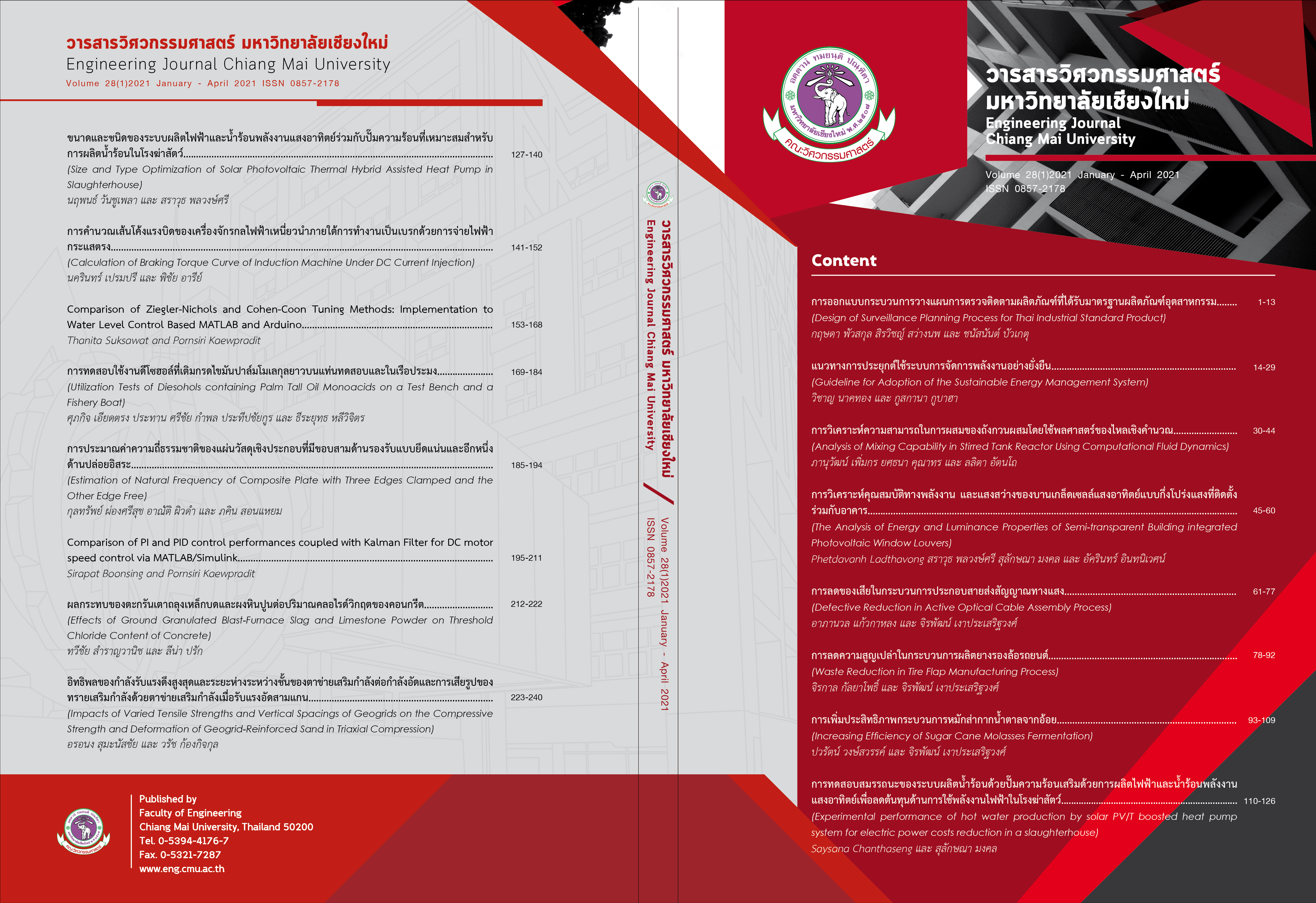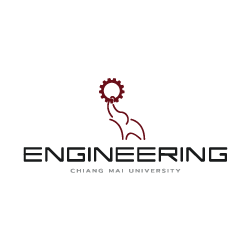Comparison of Ziegler-Nichols and Cohen-Coon Tuning Methods: Implementation to Water Level Control Based MATLAB and Arduino
Keywords:
Level control, PID, Arduino, MATLAB/Simulink, FOPDT (First Order Plus Dead Time), Kalman filterAbstract
The purpose of this study is to design a proportional (P), proportional-integral (PI), and integral derivative (PID) controller for the water level control system. The system uses Arduino as a data acquisition running through MATLAB/Simulink. Tuning methods, Zeigler-Nichols (ZN) and Cohen-Coon (CC), are based on a first order plus dead time (FOPDT) model and open-loop tuning, and the results were compared. Due to the fast development of the process industry, the higher accuracy of the system is required. Kalman filter was also applied in this study to compensate for the errors of both water level measurement and the process model. Experimental results are shown for comparison of those tuning methods without Kalman filter and the best controllers of ZN and CC tuning methods is PI controller with Kalman filter. The rise time and settling time of the ZN-PI controller with Kalman filter are 40.3 s and 170 s, respectively. The rise time and settling time of the CC-PI controller are 39.3 s and 43.0 s, respectively. The CC-PI controller with Kalman filter has a better performance with a smaller rise time and settling time. After several tests with different tuning methods, this proves the useful application and the efficiency of Kalman filter.
References
Anarase, B.V. and Parvat, B.J. Design of Model Predictive Controller for Level Process. IOSR Journal of Computer Engineering, 2016; 10-16.
Abirami, S., Hussain, Z., Saravana Muthu, A.S. and Aravind Kumar, C.B. Performance Comparison of Different Controllers for a Level Process. International Journal of Engineering Research and Applications, 2014; 4(3):341.
Dinakaran, C. Temperature and Water Level Control in Boiler by using Fuzzy Logic Controller. International Journal of Electrical Power System and Technology, 2015; 1(1),27-37.
Chew ,I.M., Wong, F., Bono,A. and Wong, K.I. Simulation of Process Identification and Controller Tuning for Flow Control System.29thSymposium of Malaysian Chemical Engineers (SOMChE) 2016,December 1-3,Miri, Malaysia, 2016.
Telepatil, A.R., Hambar, A.N. and Terwadkar, P.S. Home Automation with MATLAB and ARDUINO Interface. International Journal of Innovative Research in Computer and Communication Engineering,2017; 5(3): 5501-5507.
Anarase, B.V., Parvat, B.J. and Kadu,C.B. Design of Model Predictive Control for Non Linear Process. International Journal of Emerging Technology and Advanced Engineering,2016; 6(1): 304.
Osman U., Ishak E. and Nihat A. Embedded System Based Real Time Position Control of a Dc Motor Using Matlab. International Journal of Research in Engineering & Advanced Technology,2016; 4(5): 37-38.
Babu, A.R., Kibreab, S., Mehari, S. Experimental Studies on Step Response of Water Level Control System with P, PI and PID Control Mechanisms. International Research Journal of Engineering and Technology (IRJET), 2020; 7(10): 1504-1509.
Jaafar, H.I., Hussien, S.Y.S., Selamat,N.A. and Rashid,M.Z.A. Development of PID Controller for Controlling Desired Level of Coupled Tank System. International Journal of Innovative Technology and Exploring Engineering (IJITEE), 2014; 3(9): 32-36.
Kapale,S. and Bharakad, S. Liquid Level Estimation in Dynamic Condition using Kalman Filter. International Journal of Engineering and Application, 2016; 6(8): 12-16.
Mehmet,Y .and Özgür,V. Liquid Level Control with Different Control Methods Based on Matlab/Simulink and Arduino for the Control Systems Lesson. International Advanced Researches and Engineering Journal,2020;4(3):249-254.
Walz,S., Lazar,R., Buticchi,G. and Liserre,M. Dahlin-Based Fast and Robust Current Control of a PMSM in Case of Low Carrier Ratio. Institute of Electrical and Electronics Engineers,2019;7: 102199-102208.
How Relays Work. GALCO. [Online] Available: https://www.galco.com
External Power Supplies. ENERY STAR, 2010. [Online] Available: https://www.energystar.gov/index.cfm?c=archives.power_supplies.
Swain,S., Mandavi,D.S. and Behera, A.A. Comparison of Performance Analysis of Different Control Structures. Department of Electronics & Communication Engineering National Institute of Technology, Rourkela, 2012.
PID Controller-Working and Tuning Methods. Electronic Hubs,2015. [Online] Available: https://www.electronicshub.org.
Barber,R., Horra,M. and Crespo,J. Control Practices using Simulink with Arduino as Low Cost Hardware.The10thIFAC Symposium Advances in Control Education. August 28-30,Sheffield, UK, 2013.
Korsane D.T., Yadav V. and Raut K.H. PID Tuning Rules for First Order plus Time Delay System. International Journal of Innovative Research in Electrical, Electronics, Instrumentation and Control Engineering, 2014;2(1): 582-586.
Kumar,A. and Garg K.K. Comparison of Ziegler-Nichols, Cohen-Coon and Fuzzy Logic Controllers for Heat Exchanger Model. International Journal of Science, Engineering and Technology Research, 2015; 4(6): 1918.
Wakitani,S., Nakanishi,H., Ashida,Y. and Yamamoto,H. Study on a Kalman Filter based PID Controller.The3rdIFAC Conference on Advances in Proportional-Integral-Derivative Control, May 9-11,Ghent, Belgium, 2018.
Jovanovic,B. Kalman Filter Estimation of the Unrecorded Economy in Macedonia. National Bank of the Republic of Macedonia, 2015.
Goddard,P. An Introduction to the Kalman Filter. 2003-2020. [Online] Availablehttps://www.goddardconsulting.ca/kalman-filter.html./comp/prod/relay.htm
Joseph,E. and Olaiya,O.O. Cohen-Coon PID Tuning Method: A Better Option to Ziegler Nichols-Pid Tuning Method. Computer Engineering and Intelligent Systems, 2018;9(5): 33-37.
Downloads
Published
Issue
Section
License
ลิขสิทธิ์ของบทความที่ตีพิมพ์ในวารสารฉบับนี้จะยังเป็นของผู้แต่งและยินยอมให้สิทธิ์เผยแพร่กับทางวารสาร
การเผยแพร่ในระบบวารสารแบบเปิดนี้ บทความจะสามารถนำไปใช้ได้ฟรีในการศึกษา และในทางที่ไม่เกี่ยวกับการค้า




